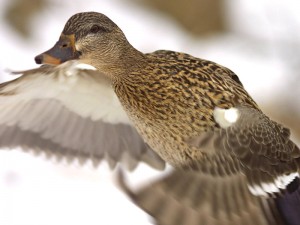Colder weather has moving birds in the Central and Mississippi Flyways this week as we near the typical major migrations of November. While the flurry of activity is providing hope to waterfowl hunter in the central tier of the United States, Gadwall numbers in the Dakotas are still above average for this time of year.
Hello folks, and, as always, welcome to Waterfowler.com.
Colder temperatures along the US/Canada border helped push migrating birds south this week, finally moving the typical migrants off the prairie. Gadwall, widgeon and green-wing teal are finally moving south – about 2-3 weeks behind schedule.
Looking back to the WFC archives, we are clearly in a typical El Nino migration. If our records hold true, we can expect a series of cold fronts followed by quick warming events into the December months. During the last El Nino event, mallards didn’t rally in southern states until mid-January.
The good news is, the diver migration is progressing normally – as these birds migrate more to the calendar than weather events. Hunters should expect an mixed bag of waterfowl over the next few weeks as the gray ducks move south.
The bulk of the mid-continental mallard population remains in Canada at this time with the first good flights arriving in Eastern Montana and the western Dakotas.
In a typical weather season, the birds will follow the Missouri River corridor into South Dakota and remain there until severe weather moves them south. Hunters in the Mississippi and Central Flyways typically see the first arctic clipper system during the second week of November, so we’ll just have to keep our fingers crossed.
In the Pacific Flyway, El Nino weather systems are helping to improve waterfowl hunting compared to the last season.







http://touringman.com/__media__/js/netsoltrademark.php?d=rcatoinc.com%2F__media__%2Fjs%2Fnetsoltrademark.php%3Fd%3Dfotosos.cc
https://ec2-52-70-39-20.compute-1.amazonaws.com/seksfotka.top
http://www.adflip.com/__media__/js/netsoltrademark.php?d=www.google.bt%2Furl%3Fq%3Dhttp%3A%2F%2Fvt.obninsk.ru%2Fforum%2Fgo.php%3Fhttps%3A%2F%2Ffotosos.cc%2F
https://newtouchrestoration.net/component/k2/item/3-importance-of-innovation-and-professionalism
http://ww31.nomadmodularbuilding.com.au/__media__/js/netsoltrademark.php?d=rates.ninja%2Fen%2Fout%2FaHR0cHM6Ly9mb3Rvc29zLmNjLw
http://vebiradoworid.school2100.com/bitrix/redirect.php?event1=click_to_call&event2=&event3=&goto=https://seksfotka.top/
https://wikimapia.org/external_link?url=https://www.google.rw/url?q=https://fotosos.cc/
https://maps.google.com.fj/url?sa=t&url=https%3A%2F%2Fvulteevaliant.com%2Findex.php%2F%E2%86%91_Could_Porn_Be_Good_For_Society
http://m.beneq.com/__media__/js/netsoltrademark.php?d=proxy.lib.uiowa.edu%2Flogin%3Furl%3Dhttp%3A%2F%2Fozerny.ru%2Fbitrix%2Fredirect.php%3Fevent1%3D%26event2%3D%26event3%3D%26goto%3Dhttps%3A%2F%2Ffotosos.cc%2F
https://www.tsijournals.com/user-logout.php?redirect_url=https://seksfotka.top/
http://vvaldezphoto.com/?wptouch_switch=mobile&redirect=http%3a%2f%2ffotosos.cc
http://miller-garage.com/__media__/js/netsoltrademark.php?d=kyeyangencplus.co.kr%2Fbbs%2Fboard.php%3Fbo_table%3Dfree%26wr_id%3D1124919
http://contentmarketingland.com/__media__/js/netsoltrademark.php?d=fotosos.cc
http://m.landing.siap-online.com/?goto=https://seksfotka.top/
http://ihatemichaelscrafts.com/__media__/js/netsoltrademark.php?d=fotosos.cc
http://aidannassiri.com/__media__/js/netsoltrademark.php?d=seksfotka.top
http://www.endofmoney.com/__media__/js/netsoltrademark.php?d=fotosos.cc
https://secondchanceshepherds.org/pics/aHR0cHM6Ly93d3cuYWRtaW5lci5vcmcvcmVkaXJlY3QvP3VybD1odHRwcyUzQSUyRiUyRnBpbmFsbC5vcmclMkZiaXRyaXglMkZyZWRpcmVjdC5waHAlM0Znb3RvJTNEaHR0cHMlM0ElMkYlMkZzZWtzZm90a2EudG9wJTJG
https://dodgeownerforums.com/smf/index.php?thememode=full;redirect=https://edmullen.net/gbook/go.php?url=https://metricapp.co/2021/08/18/lower-operating-expenses-business/
http://dcdmedia.co.uk/?URL=https://seksfotka.top/